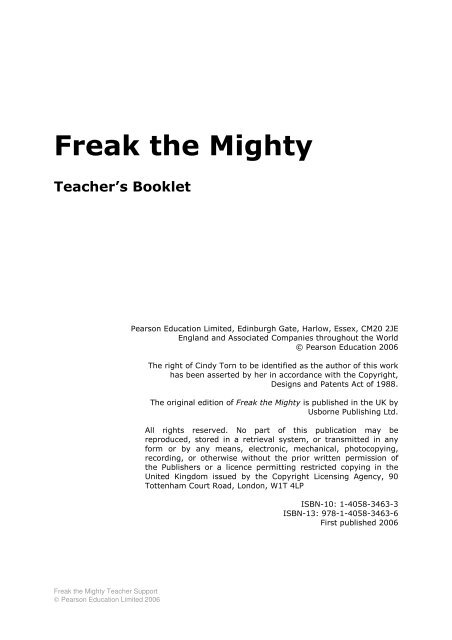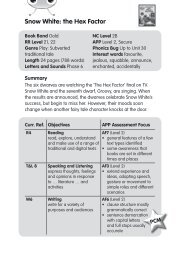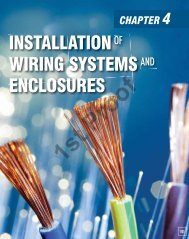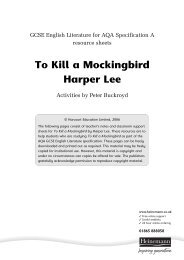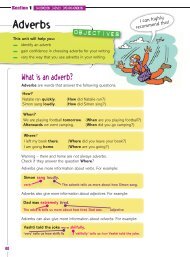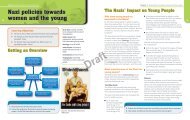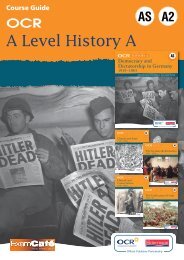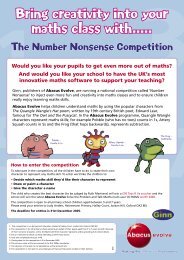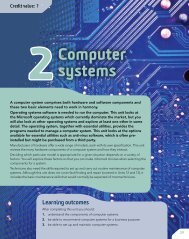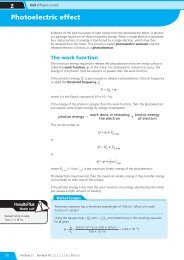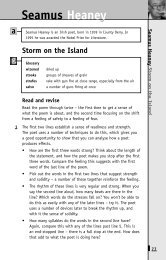Freak the Mighty - Pearson Schools
Freak the Mighty - Pearson Schools
Freak the Mighty - Pearson Schools
Create successful ePaper yourself
Turn your PDF publications into a flip-book with our unique Google optimized e-Paper software.
<strong>Freak</strong> <strong>the</strong> <strong>Mighty</strong><br />
Teacher’s Booklet<br />
<strong>Pearson</strong> Education Limited, Edinburgh Gate, Harlow, Essex, CM20 2JE<br />
England and Associated Companies throughout <strong>the</strong> World<br />
© <strong>Pearson</strong> Education 2006<br />
The right of Cindy Torn to be identified as <strong>the</strong> author of this work<br />
has been asserted by her in accordance with <strong>the</strong> Copyright,<br />
Designs and Patents Act of 1988.<br />
The original edition of <strong>Freak</strong> <strong>the</strong> <strong>Mighty</strong> is published in <strong>the</strong> UK by<br />
Usborne Publishing Ltd.<br />
All rights reserved. No part of this publication may be<br />
reproduced, stored in a retrieval system, or transmitted in any<br />
form or by any means, electronic, mechanical, photocopying,<br />
recording, or o<strong>the</strong>rwise without <strong>the</strong> prior written permission of<br />
<strong>the</strong> Publishers or a licence permitting restricted copying in <strong>the</strong><br />
United Kingdom issued by <strong>the</strong> Copyright Licensing Agency, 90<br />
Tottenham Court Road, London, W1T 4LP<br />
ISBN-10: 1-4058-3463-3<br />
ISBN-13: 978-1-4058-3463-6<br />
First published 2006<br />
<strong>Freak</strong> <strong>the</strong> <strong>Mighty</strong> Teacher Support<br />
© <strong>Pearson</strong> Education Limited 2006
Introduction<br />
Synopsis<br />
<strong>Freak</strong> <strong>the</strong> <strong>Mighty</strong> explores <strong>the</strong> unlikely friendship between Max and Kevin. Both boys<br />
have to face <strong>the</strong>ir ‘difference’ from <strong>the</strong> rest of <strong>the</strong> world: Max because of his size, and <strong>the</strong><br />
fact that everyone is scared of him because of his dad, and <strong>the</strong> events surrounding his<br />
mo<strong>the</strong>r’s death; Kevin because of his size and his disabilities. During this fast-paced<br />
novel, both Max and Kevin have to confront and overcome challenges which would daunt<br />
even <strong>the</strong> strongest hero. It is through <strong>the</strong>ir friendship that <strong>the</strong>y become ‘<strong>Freak</strong> <strong>the</strong><br />
<strong>Mighty</strong>’ and discover that ‘difference’ doesn’t have to mean weakness.<br />
Teaching <strong>Freak</strong> <strong>the</strong> <strong>Mighty</strong> at Key Stage 3<br />
The novel, which is both humorous and sad, explores <strong>the</strong> <strong>the</strong>mes of friendship, being an<br />
outsider, and <strong>the</strong> power of language and education. Its setting is poor, urban America –<br />
not <strong>the</strong> standard view of American life. The families portrayed are unusual; we are shown<br />
different family set-ups – from single parents to families torn apart. The novel tackles<br />
serious subjects in a humorous way and shows clearly how we can find strength through<br />
friendship and unity.<br />
There are sensitive issues within <strong>the</strong> novel that <strong>the</strong> teacher will need to face. The<br />
language used to describe disability is often uncompromising and <strong>the</strong> teacher will need to<br />
explore how our society often labels people who are different. However, <strong>the</strong> novel is<br />
uplifting and <strong>the</strong> reader, along with Max, learns <strong>the</strong> importance of seeing beyond<br />
disability.<br />
Structure of this resource<br />
This resource provides suggestions for activities which can be easily slotted into a<br />
scheme of work around <strong>the</strong> novel. It consists of two parts: <strong>the</strong> overview of teaching<br />
and learning and <strong>the</strong> resources.<br />
The overview of teaching and learning aims to secure progression in learning, ra<strong>the</strong>r<br />
than just progression through <strong>the</strong> pages. It has been divided into eight natural sections.<br />
The overview for each section indicates:<br />
• <strong>the</strong> chapters to be read<br />
• <strong>the</strong> features of <strong>the</strong> text to be explored<br />
• <strong>the</strong> learning aims for <strong>the</strong> section (including Assessment focuses)<br />
• brief descriptions of <strong>the</strong> approaches to teaching.<br />
The resources comprise:<br />
• Pupil worksheets (which can be photocopied)<br />
• Teacher support sheets/OHTs etc<br />
• Assessment criteria, grids etc.<br />
<strong>Freak</strong> <strong>the</strong> <strong>Mighty</strong> Teacher Support<br />
© <strong>Pearson</strong> Education Limited 2006
Overview of teaching and learning<br />
Section<br />
Pre-reading<br />
Resources<br />
Resource Sheet<br />
1<br />
Features to explore<br />
during reading<br />
• Exploration of <strong>the</strong> place of<br />
‘<strong>the</strong> quest’ in literature.<br />
Show students that <strong>the</strong>re<br />
are stages within a quest,<br />
and that heroes follow a<br />
journey.<br />
• Exploration of how writers<br />
use established structures<br />
to create new texts.<br />
Learning targets<br />
Learning focuses<br />
To be able to:<br />
• understand how<br />
texts fit within a<br />
literary heritage<br />
• explore how writers<br />
use and manipulate<br />
established story<br />
structures.<br />
Activities<br />
Activity 1: Quest genre films<br />
• Think about quest genre films with <strong>the</strong> pupils, e.g. Star Wars, Harry<br />
Potter, Lord of <strong>the</strong> Rings. Use Resource Sheet 1 to focus paired<br />
discussion of how <strong>the</strong>ir chosen film matches and/or departs from <strong>the</strong><br />
quest structure.<br />
Extension<br />
• Those pupils who have completed Resource Sheet 1 should write<br />
down what <strong>the</strong>y think are <strong>the</strong> established literary conventions for a<br />
hero, i.e. how do writers portray heroes?<br />
Assessment focuses<br />
and Framework<br />
objectives<br />
Reading AF3: 7R6, 7R20<br />
<strong>Freak</strong> <strong>the</strong> <strong>Mighty</strong> Teacher Support<br />
© <strong>Pearson</strong> Education Limited 2006
Section<br />
Chapters 1-2<br />
Before <strong>Freak</strong> <strong>the</strong><br />
<strong>Mighty</strong><br />
Resources<br />
Resource Sheet<br />
2<br />
Resource Sheet<br />
3<br />
Features to explore<br />
during reading<br />
• Challenge assumptions<br />
about American society.<br />
• Exploration of <strong>the</strong> notion<br />
of ‘<strong>the</strong> hero’ in literature.<br />
• Explanation that <strong>the</strong>re are<br />
literary conventions which<br />
writers use and adapt for<br />
<strong>the</strong>ir own means.<br />
• Analysis of Max’s origins<br />
and <strong>the</strong> reader’s first<br />
impressions of him. How<br />
far does this meet <strong>the</strong><br />
criteria of <strong>the</strong> hero?<br />
Learning targets<br />
Learning focuses<br />
To be able to:<br />
• understand that<br />
<strong>the</strong>re are literary<br />
conventions for<br />
heroes.<br />
• understand how<br />
writers establish our<br />
first impressions of a<br />
character.<br />
Assessment focuses<br />
and Framework<br />
objectives<br />
Reading AF6: 7R12,<br />
7R20<br />
Activities<br />
Activity 1: Analysing expectations<br />
• Discuss with <strong>the</strong> class what <strong>the</strong>ir expectations are about family life in<br />
America. The brainstorm can be stored for later discussions.<br />
Activity 2: Exploring character<br />
• Cut out <strong>the</strong> grid of statements on Resource Sheet 2 and group<br />
<strong>the</strong>m into positive and negative impressions of Max.<br />
• Then on Resource Sheet 3 ask pupils to fill in <strong>the</strong> boxes with <strong>the</strong>ir<br />
thoughts about Max. This will help with a close reading of <strong>the</strong> text.<br />
• Capture initial impressions of Max and align his portrayal with<br />
conventions of <strong>the</strong> hero and <strong>the</strong> hero’s journey.<br />
Extension<br />
• Explore how Max’s feelings about himself can be interpreted through<br />
<strong>the</strong> language he uses.<br />
<strong>Freak</strong> <strong>the</strong> <strong>Mighty</strong> Teacher Support<br />
© <strong>Pearson</strong> Education Limited 2006
Section<br />
Chapters 3–6<br />
Arrival of <strong>Freak</strong><br />
<strong>the</strong> <strong>Mighty</strong><br />
Resources<br />
Resource Sheet<br />
4<br />
Resource Sheet<br />
5<br />
Features to explore<br />
during reading<br />
• A return to <strong>the</strong> quest<br />
structure and a matching<br />
of <strong>the</strong> features of <strong>the</strong><br />
hero’s journey with <strong>the</strong><br />
events in <strong>the</strong> novel.<br />
• Analysis of Max’s thoughts<br />
and reactions to Kevin<br />
within <strong>the</strong>se chapters.<br />
Establishing how his initial<br />
impressions change: how<br />
<strong>the</strong> writer achieves this.<br />
Learning targets<br />
Learning focuses<br />
To be able to:<br />
• understand and<br />
identify how and why<br />
ideas are structured<br />
in a text by <strong>the</strong><br />
writer.<br />
• understand how<br />
writers convey<br />
character and<br />
understand how<br />
characters develop<br />
during <strong>the</strong> course of<br />
a novel.<br />
Activities<br />
Activity 1: Text structure<br />
• After reading Chapters 3 to 6, hand out Resource Sheet 4 and<br />
establish <strong>the</strong> relevant stages of <strong>the</strong> hero’s journey. Model how <strong>the</strong><br />
call to adventure could match <strong>the</strong> growing idea of friendship between<br />
Max and Kevin.<br />
• As a whole class, ask pupils to consider how Max’s views of Kevin<br />
change through Chapters 3 to 6. Then, split <strong>the</strong> class into groups and<br />
allocate each group a separate chapter. They should look for textual<br />
evidence of <strong>the</strong> change in Max’s views in <strong>the</strong>ir specific chapter.<br />
Individuals should record final ideas on Resource Sheet 5. They can<br />
<strong>the</strong>n feed <strong>the</strong> information back to <strong>the</strong> class to formulate a joint<br />
answer.<br />
Assessment focuses<br />
and Framework<br />
objectives<br />
Reading AF4:<br />
7R7<br />
Reading AF5:<br />
7R12<br />
<strong>Freak</strong> <strong>the</strong> <strong>Mighty</strong> Teacher Support<br />
© <strong>Pearson</strong> Education Limited 2006
Section<br />
Chapters 7–10<br />
Being <strong>Freak</strong> <strong>the</strong><br />
<strong>Mighty</strong><br />
Resources<br />
Resource Sheet<br />
6 (OHT)<br />
Resource Sheet<br />
7<br />
Resource Sheet<br />
8<br />
Features to explore<br />
during reading<br />
• Analysis of <strong>the</strong> language<br />
used to describe Max and<br />
Kevin.<br />
• Exploration of archetypes<br />
and <strong>the</strong> language of<br />
knightly deeds.<br />
Learning targets<br />
Learning focuses<br />
To be able to:<br />
• understand how <strong>the</strong><br />
writer uses language<br />
to convey character.<br />
Assessment focuses<br />
and Framework<br />
objectives<br />
Reading AF5: 7R12<br />
Activities<br />
Activity 1: Text analysis<br />
• Use Resource Sheet 6 on <strong>the</strong> OHP to model annotation in order to<br />
show how Kevin uses language to describe Max as a horse.<br />
Activity 2: Exploration of language<br />
• Read <strong>the</strong> passage at <strong>the</strong> end of Chapter 8 in which Kevin defines<br />
‘archetype’. Explore with <strong>the</strong> class <strong>the</strong> idea of knights and what our<br />
concept and expectations of <strong>the</strong>m are.<br />
Activity 3: More exploration of language<br />
• Split <strong>the</strong> class into groups and ask <strong>the</strong>m to skim-read Chapters 7 to<br />
10 to find language relating to knights and Arthurian legends. Hand<br />
out Resource Sheet 7; individual groups should discuss how <strong>Freak</strong><br />
<strong>the</strong> <strong>Mighty</strong> can be seen as a knight.<br />
Assessment Exercise<br />
• To be completed after reading Chapter 10. The purpose of this task<br />
is to assess AF3 and AF5 Reading using Speaking and Listening. The<br />
focus for this assessment is <strong>the</strong> question: How does Kevin’s language<br />
make him different? Pupils analyse <strong>the</strong> ways that <strong>the</strong> language Kevin<br />
uses in Chapters 1–10 helps to show how he is different from o<strong>the</strong>r<br />
people.<br />
• Using a jigsaw technique for grouping, <strong>the</strong> class will discuss <strong>the</strong><br />
question in <strong>the</strong>ir expert groups and <strong>the</strong>n present <strong>the</strong>ir findings to<br />
<strong>the</strong>ir ‘home’ group as a formal presentation. Resource Sheet 8 can<br />
be used for <strong>the</strong> pupils to collect <strong>the</strong>ir ideas. See Resource Sheet 9<br />
for details on how to execute this. The feedback to ‘home’ groups will<br />
enable a Speaking and Listening assessment of En2.<br />
<strong>Freak</strong> <strong>the</strong> <strong>Mighty</strong> Teacher Support<br />
© <strong>Pearson</strong> Education Limited 2006
Section<br />
Chapters 11–<br />
14<br />
Friends and<br />
Enemies<br />
Resources<br />
Resource Sheet<br />
10<br />
Resource sheet<br />
11<br />
Features to explore<br />
during reading<br />
• The language used to<br />
describe Iggy and Loretta<br />
Lee. How are <strong>the</strong>y<br />
presented as villains?<br />
Learning targets<br />
Learning focuses<br />
To be able to:<br />
• understand that<br />
writers use language<br />
symbolically.<br />
• understand that<br />
writers use setting to<br />
establish character.<br />
Assessment focuses<br />
and Framework<br />
objectives<br />
Reading AF5: 7R12,<br />
7R14<br />
Activities<br />
Activity 1: Positive and negative language<br />
• Hand out Resource Sheet 10 and ask pupils to think about positive<br />
and negative language to give an impression of character. Pupils<br />
draw images of Iggy and Loretta based on <strong>the</strong> impression <strong>the</strong> writer<br />
has painted with words. After this <strong>the</strong>y should group-read Chapter<br />
11, adding to <strong>the</strong>ir initial responses to <strong>the</strong> characters.<br />
Activity 2: Text analysis: setting<br />
• Hand out Resource Sheet 11. Pupils review Chapter 11 and<br />
investigate <strong>the</strong> way in which <strong>the</strong> writer has used <strong>the</strong> setting of <strong>the</strong><br />
Testaments and <strong>the</strong> interior of <strong>the</strong> Lees’ apartment to build a sense<br />
that <strong>the</strong>y are dangerous and will cause trouble for <strong>Freak</strong> and Max.<br />
Extension<br />
• Pupils who have completed <strong>the</strong> activities above easily should identify<br />
ways in which <strong>the</strong> writer hints that Loretta and Iggy are perhaps not<br />
as villainous as we might at first perceive.<br />
<strong>Freak</strong> <strong>the</strong> <strong>Mighty</strong> Teacher Support<br />
© <strong>Pearson</strong> Education Limited 2006
Section<br />
Chapters 15–<br />
20<br />
Return of <strong>the</strong><br />
Fa<strong>the</strong>r<br />
Resources<br />
Resource Sheet<br />
12<br />
Resource Sheet<br />
13<br />
Resource Sheet<br />
14<br />
Resource Sheet<br />
15<br />
Resource Sheet<br />
16<br />
Features to explore<br />
during reading<br />
• Interpretation of <strong>the</strong><br />
language used – what<br />
does it suggest about<br />
Max’s feelings and<br />
reactions?<br />
• Analysis of how <strong>the</strong> threat<br />
posed by Kenny Kane is<br />
conveyed to <strong>the</strong> reader<br />
through inference and<br />
deduction.<br />
• Investigation of <strong>the</strong><br />
reader’s fears: will Max<br />
fail this test?<br />
Learning targets<br />
Learning focuses<br />
To be able to:<br />
• understand <strong>the</strong><br />
difference between<br />
surface meaning and<br />
hidden meaning<br />
• understand how <strong>the</strong><br />
writer creates doubt<br />
in <strong>the</strong> reader’s mind<br />
• understand how<br />
Max’s feelings are<br />
suggested by <strong>the</strong><br />
language of <strong>the</strong> text.<br />
Assessment focuses<br />
and Framework<br />
objectives<br />
Reading AF3: 7R8<br />
Reading AF5: 7R8, 7R12,<br />
7R14<br />
Activities<br />
Activity 1: Sorting quotations<br />
• Having read Chapter 16, pupils should sort <strong>the</strong> cards of quotations<br />
on Resource Sheet 12 into categories to facilitate discussion of <strong>the</strong><br />
text and to focus attention on <strong>the</strong> effects of <strong>the</strong> language used by <strong>the</strong><br />
writer. Create a spectrum of Max’s reactions based on <strong>the</strong> class’s<br />
findings to encourage critical response of <strong>the</strong> text.<br />
Extension<br />
• Pupils who have completed <strong>the</strong> task above should look at how <strong>the</strong><br />
writer uses similes when Max expresses himself. This information<br />
could be fed back to <strong>the</strong> class later in <strong>the</strong> lesson.<br />
Activity 2: Use of language<br />
• Pupils read Chapter 17 and <strong>the</strong>n recap on Chapter 16 by analysing<br />
<strong>the</strong> ways in which Kenny Kane’s threat is conveyed by <strong>the</strong> writer,<br />
using Resource Sheet 13. Use this to model thinking.<br />
Activity 3: Hidden meanings<br />
• In groups, pupils read Chapter 17 looking for surface ‘goodness’ and<br />
inferred ‘threat’ and record details on Resource Sheet 14.<br />
Extension<br />
• Pupils who have completed <strong>the</strong> activities above should investigate<br />
how convincing Kenny Kane’s acting is and plot <strong>the</strong>ir findings on <strong>the</strong><br />
graph on Resource Sheet 15 as <strong>the</strong>y read.<br />
Activity 4: Max’s feelings<br />
• Recap on Chapters 16 to 19 with <strong>the</strong> game on Resource Sheet 16.<br />
This focuses on details which lead <strong>the</strong> reader to worry that Max has<br />
been convinced by Kenny Kane and has failed his fa<strong>the</strong>r’s ‘test’.<br />
Activity 5: Text analysis<br />
• Pupils read Chapter 20 in groups of four. They should ga<strong>the</strong>r notes<br />
on <strong>the</strong> ways in which Max proves himself and ‘passes’ <strong>the</strong> test.<br />
Afterwards, <strong>the</strong>y plan and show five moving snapshots that show<br />
Max proving himself, each lasting no more than three seconds.<br />
<strong>Freak</strong> <strong>the</strong> <strong>Mighty</strong> Teacher Support<br />
© <strong>Pearson</strong> Education Limited 2006<br />
Activity 6: Discussion<br />
• Discuss whe<strong>the</strong>r pupils think that Max passes this test alone. Is he<br />
independent or is it <strong>Freak</strong> <strong>the</strong> <strong>Mighty</strong> who passes <strong>the</strong> test? Model and<br />
encourage <strong>the</strong> use of evidence from <strong>the</strong> text to support points made.
Section<br />
Chapters 21–<br />
24<br />
A Death<br />
Resources<br />
Resource Sheet<br />
17<br />
Resource Sheet<br />
18<br />
Features to explore<br />
during reading<br />
• Max’s growing<br />
independence from <strong>Freak</strong>.<br />
• The ways in which <strong>the</strong><br />
writer has hinted at<br />
<strong>Freak</strong>’s death in Chapters<br />
21–23.<br />
Learning targets<br />
Learning focuses<br />
To be able to:<br />
• identify how Max’s<br />
independence grows.<br />
• understand how <strong>the</strong><br />
writer prepares us for<br />
<strong>Freak</strong>’s death.<br />
Assessment focuses<br />
and Framework<br />
objectives<br />
Reading AF2: 7R12<br />
Reading AF3: 7R12<br />
Reading AF6: 7R15<br />
Activities<br />
Activity 1: Character development<br />
• Pupils split into reading groups to read Chapters 21 to 23. Using<br />
Resource Sheet 17, <strong>the</strong>y investigate Max’s growing independence<br />
from <strong>Freak</strong> and confidence in his own abilities. Each individual in<br />
each group is given a specific focus on which to become an ‘expert’,<br />
in preparation to explain <strong>the</strong>ir findings to a new group.<br />
Extension<br />
• In a separate reading group, those pupils who have finished <strong>the</strong><br />
activity above look at details which indicate that perhaps Max still<br />
hasn’t finished growing and that he needs to develop fur<strong>the</strong>r before<br />
he can stand alone without Kevin. They should present <strong>the</strong>ir findings<br />
to <strong>the</strong> class at <strong>the</strong> end of <strong>the</strong> lesson.<br />
Activity 2: Anticipating <strong>the</strong> ending<br />
• After reading Chapter 24, pupils investigate how <strong>the</strong> writer prepares<br />
us for <strong>Freak</strong>’s death in Chapters 21 to 23. See Resource Sheet 18.<br />
After this, <strong>the</strong>y practise extracting relevant details from pages 138–<br />
39 in Chapter 24.<br />
<strong>Freak</strong> <strong>the</strong> <strong>Mighty</strong> Teacher Support<br />
©<strong>Pearson</strong> Education 2006
Section<br />
Chapter 25 and<br />
Dictionary<br />
After <strong>Freak</strong><br />
Resources<br />
Resource Sheet<br />
19<br />
Resource Sheet<br />
20 (Assessment)<br />
Resource Sheet<br />
21 (Assessment)<br />
Resource Sheet<br />
22<br />
Resource Sheet<br />
23<br />
Features to explore<br />
during reading<br />
• Study of <strong>the</strong> meanings of<br />
<strong>the</strong> words in Kevin’s<br />
dictionary. How do <strong>the</strong>y<br />
relate to <strong>the</strong> rest of <strong>the</strong><br />
story?<br />
• Review of <strong>the</strong> structure of<br />
<strong>the</strong> novel, using <strong>the</strong><br />
structure of a typical<br />
quest.<br />
Learning targets<br />
Learning focuses<br />
To be able to:<br />
• understand <strong>the</strong><br />
journeys undertaken<br />
by Max in <strong>the</strong> novel.<br />
• understand that <strong>the</strong><br />
structure of <strong>the</strong> novel<br />
is similar to that of a<br />
typical hero’s quest.<br />
Assessment focuses<br />
and Framework<br />
objectives<br />
Reading AF4: 7R15<br />
Reading AF5: 7R12,<br />
7R15<br />
Activities<br />
Activity 1: Word work<br />
• Using Resource Sheet 19 and <strong>the</strong> dictionary, put <strong>the</strong> pupils into<br />
pairs and ask <strong>the</strong>m to investigate links between <strong>the</strong> dictionary and<br />
<strong>the</strong> journeys Max has made through his relationship with Kevin.<br />
Discuss how <strong>the</strong> words relate to Max’s different journeys.<br />
Assessment Exercise<br />
• To be carried out after reading Chapter 25 and <strong>the</strong> dictionary. The<br />
purpose of this task is to analyse <strong>the</strong> ways that <strong>the</strong> language and<br />
ideas of Chapter 25 help to show that Max has developed as a<br />
character over <strong>the</strong> course of <strong>the</strong> novel. The investigation should be<br />
completed in pairs, using Resource Sheets 20 and 21. A fur<strong>the</strong>r<br />
shaping of ideas, using Resource Sheet 22, will lead to a Speaking<br />
and Listening assessment of En2 as pupil pairs explain <strong>the</strong>ir ideas<br />
and findings to ano<strong>the</strong>r pair.<br />
Activity 2: Novel structure<br />
• Using Resource Sheet 23 which describes <strong>the</strong> template of a typical<br />
quest structure, pupils discuss how <strong>the</strong> events of <strong>the</strong> novel relate to<br />
those of a typical hero’s quest.<br />
<strong>Freak</strong> <strong>the</strong> <strong>Mighty</strong> Teacher Support<br />
©<strong>Pearson</strong> Education 2006
Pupil Resource Sheet 1<br />
Task<br />
With a partner, think about films that follow a quest, e.g. Star Wars, Harry Potter<br />
or Lord of <strong>the</strong> Rings. Use this sheet to discuss how your chosen film matches<br />
and/or departs from <strong>the</strong> quest structure.<br />
The ordinary<br />
world<br />
The call to<br />
adventure<br />
Refusal of <strong>the</strong><br />
call<br />
Mentor<br />
Crossing <strong>the</strong><br />
first threshold<br />
Tests, allies<br />
and enemies<br />
Approach to<br />
<strong>the</strong> inmost<br />
cave<br />
The supreme<br />
ordeal<br />
Reward<br />
The road back<br />
Resurrection<br />
The ordinary world is shown in order to provide a contrast<br />
with <strong>the</strong> ‘new’ world <strong>the</strong> hero is about to enter.<br />
The hero is presented with a problem, challenge or<br />
adventure. As soon as <strong>the</strong>y know about this call <strong>the</strong>y can no<br />
longer be comfortable in <strong>the</strong> ordinary world. The hero’s goal<br />
is made clear: to win <strong>the</strong> treasure; get revenge; right a<br />
wrong; confront a challenge or achieve a dream.<br />
The hero becomes reluctant to take on <strong>the</strong> challenge and<br />
may start to think of turning back. Advice from a mentor or<br />
some o<strong>the</strong>r circumstance is needed to enable <strong>the</strong> hero to<br />
overcome this fear.<br />
The mentor helps <strong>the</strong> hero prepare for <strong>the</strong> adventure. He or<br />
she gives guidance and sometimes magical equipment.<br />
They can only travel part of <strong>the</strong> journey with <strong>the</strong> hero and<br />
at this point can give stern advice to <strong>the</strong> hero to get <strong>the</strong><br />
adventure going.<br />
The hero commits to <strong>the</strong> adventure, agrees to face <strong>the</strong><br />
consequences of <strong>the</strong> challenge and enters <strong>the</strong> special world<br />
of <strong>the</strong> story. This is where <strong>the</strong> adventure starts.<br />
The hero begins to face <strong>the</strong> challenges of <strong>the</strong> new world. He<br />
or she meets new friends and enemies. Often <strong>the</strong> settings<br />
can be dark and dangerous and <strong>the</strong> hero’s determination to<br />
complete <strong>the</strong> adventure is tested.<br />
The hero comes to <strong>the</strong> edge of a dangerous place where <strong>the</strong><br />
object of <strong>the</strong> quest is hidden. When <strong>the</strong> place is entered, <strong>the</strong><br />
hero crosses <strong>the</strong> second threshold. Often heroes pause at<br />
<strong>the</strong> gate to prepare and plan.<br />
The hero has to face his or her greatest fear. They will also<br />
face death and will battle with <strong>the</strong> enemy.<br />
The hero wins <strong>the</strong> treasure. This treasure could be<br />
knowledge and reconciliation with <strong>the</strong> enemy.<br />
The hero must face <strong>the</strong> consequences of <strong>the</strong> battle with <strong>the</strong><br />
enemy. If <strong>the</strong>re has been no reconciliation, <strong>the</strong> enemy may<br />
return to chase <strong>the</strong> hero as <strong>the</strong>y make <strong>the</strong>ir way back to <strong>the</strong><br />
ordinary world.<br />
The hero must be re-born in order to return to <strong>the</strong> normal<br />
world. The hero faces ano<strong>the</strong>r brush with death. The lessons<br />
learned from <strong>the</strong> supreme ordeal help <strong>the</strong> hero to win<br />
through.<br />
<strong>Freak</strong> <strong>the</strong> <strong>Mighty</strong> Pupil Resource Sheet 1<br />
©<strong>Pearson</strong> Education 2006
Pupil Resource Sheet 2<br />
Task<br />
Cut <strong>the</strong> grid into cards. Work in pairs to sort <strong>the</strong> statements about Max into <strong>the</strong><br />
following categories:<br />
• Statements which show Max positively<br />
• Statements which show Max negatively<br />
• Statements which could be positive or negative<br />
I never had a brain until <strong>Freak</strong><br />
came along<br />
I had a way of saying things<br />
with my fists<br />
I knew what a rotten lie that<br />
hug stuff was<br />
…you don’t even know yet how<br />
we got to be <strong>Freak</strong> <strong>the</strong> <strong>Mighty</strong>.<br />
Which was pretty cool…<br />
Not that I have any ideas. My<br />
brain is vacant, okay?<br />
For a long time I never saw<br />
<strong>Freak</strong> any more…and <strong>the</strong> next<br />
thing I remember I’m like in<br />
<strong>the</strong> third grade or something<br />
and I catch a glimpse of this<br />
yellow-haired kid scowling at<br />
me…<br />
Maybe it was those crutches<br />
kept me from lashing out at<br />
him…<br />
Gram and Grim, bless <strong>the</strong>ir<br />
pointed little heads<br />
And for some reason little<br />
Kicker never got around to<br />
kicking little <strong>Freak</strong>.<br />
…do I complain about <strong>the</strong><br />
crummy panelling… I do not.<br />
<strong>Freak</strong> <strong>the</strong> <strong>Mighty</strong> Pupil Resource Sheet 2<br />
©<strong>Pearson</strong> Education 2006
Pupil Resource Sheet 3<br />
Impressions of where Max lives<br />
Things Max says about himself<br />
(A hero may come from humble or disadvantaged origins)<br />
Max – a<br />
hero?<br />
How Max thinks o<strong>the</strong>r people see him<br />
How does Max fit <strong>the</strong> ‘hero’ pattern?<br />
(A hero may have a weakness or a flaw in <strong>the</strong>ir character)<br />
<strong>Freak</strong> <strong>the</strong> <strong>Mighty</strong> Pupil Resource Sheet 3<br />
©<strong>Pearson</strong> Education 2006
Pupil Resource Sheet 4<br />
Task<br />
Think about <strong>the</strong> events in Chapters 3 to 6. How do <strong>the</strong>y match <strong>the</strong> stages of <strong>the</strong><br />
hero’s journey? With a partner, discuss how <strong>the</strong>y match and where you think <strong>the</strong><br />
similarities and differences may be.<br />
Consider <strong>the</strong> following questions:<br />
• What is Max’s call to adventure?<br />
• How or why does he refuse that call?<br />
• Who do you think <strong>the</strong> mentor might be?<br />
• Could it be more than one person?<br />
Analysing <strong>the</strong> structure in Chapters 3 to 6<br />
Stages of <strong>the</strong> hero’s journey<br />
The call to adventure<br />
The hero is presented with a problem,<br />
challenge, or adventure to undertake.<br />
As soon as <strong>the</strong>y know about this call<br />
<strong>the</strong>y can no longer be comfortable in<br />
<strong>the</strong> ordinary world. The hero’s goal is<br />
made clear: to win treasure, get<br />
revenge, right a wrong, confront a<br />
challenge, or achieve a dream.<br />
Refusal of <strong>the</strong> call<br />
The hero becomes reluctant to take on<br />
<strong>the</strong> challenge and may start thinking of<br />
turning back. Advice from <strong>the</strong> mentor<br />
or some o<strong>the</strong>r circumstance is needed<br />
to enable <strong>the</strong> hero to overcome fear.<br />
Mentor<br />
The mentor helps <strong>the</strong> hero prepare for<br />
<strong>the</strong> adventure. He or she gives<br />
guidance and sometimes magical<br />
equipment. They can only travel part of<br />
<strong>the</strong> journey with <strong>the</strong> hero and at this<br />
point can give stern advice to <strong>the</strong> hero<br />
to get <strong>the</strong> adventure going.<br />
Similarities<br />
Events from <strong>the</strong> novel<br />
Differences<br />
<strong>Freak</strong> <strong>the</strong> <strong>Mighty</strong> Pupil Resource Sheet 4<br />
©<strong>Pearson</strong> Education 2006
Pupil Resource Sheet 5<br />
Task<br />
In Chapters 3 to 6, Max’s views of Kevin change many times.<br />
Using <strong>the</strong> thought bubbles below, map how his thoughts and feelings change.<br />
Remember to explain why you had that idea and back up your ideas with<br />
evidence from <strong>the</strong> text.<br />
Max’s first thoughts about Kevin:<br />
Max’s later thoughts about<br />
Kevin:<br />
<strong>Freak</strong> <strong>the</strong> <strong>Mighty</strong> Pupil Resource Sheet 5<br />
©<strong>Pearson</strong> Education 2006
Teacher Resource Sheet 6 (OHT)<br />
Chapter 7, pages 31–32<br />
“Left!” <strong>Freak</strong> says, and he kicks me with his little<br />
foot, like he’s digging into a horse and it clicks in<br />
my head. Go that way! Follow <strong>the</strong> feet! “Faster,”<br />
<strong>Freak</strong> is saying, and he’s urging me on, it’s lucky<br />
for me <strong>the</strong> little dude doesn’t have any spurs,<br />
but I don’t care, I just want to get clear of<br />
Blade.<br />
“Warp factor nine!” <strong>Freak</strong> is shouting. “More<br />
speed, o mighty beast!”<br />
Now I’m running at a full gallop, weaving<br />
through <strong>the</strong> crowd, and I don’t even need to<br />
look back, all I have to do is follow <strong>the</strong> way<br />
<strong>Freak</strong> is kicking his feet, steering me. I’m pretty<br />
sure we’re getting away until this punk comes<br />
out of nowhere, he’s one of Blade’s gang and<br />
he’s got this big ugly grin.<br />
<strong>Freak</strong> <strong>the</strong> <strong>Mighty</strong> Teacher Resource Sheet 6<br />
©<strong>Pearson</strong> Education 2006
Pupil Resource Sheet 7<br />
Task<br />
In Chapters 7 to 10, Kevin uses language which refers to knights and<br />
<strong>the</strong>ir quests. In <strong>the</strong>se chapters <strong>the</strong>re are events which cause <strong>the</strong><br />
reader to think of rescues, journeys and knightly deeds.<br />
Skim-read <strong>the</strong> chapters to find examples of <strong>the</strong>se events and use <strong>the</strong><br />
organiser below to record your ideas.<br />
Rescues,<br />
journeys<br />
and<br />
knightly<br />
deeds<br />
Knights<br />
and<br />
knightly<br />
quests<br />
Examples<br />
of<br />
language<br />
referring<br />
to knights<br />
and quests<br />
Language<br />
describing<br />
Max as a<br />
horse<br />
<strong>Freak</strong> <strong>the</strong> <strong>Mighty</strong> Pupil Resource Sheet 7<br />
©<strong>Pearson</strong> Education 2006
Pupil Resource Sheet 8<br />
e.g.<br />
horse<br />
images<br />
Language he<br />
uses about<br />
Max<br />
e.g.<br />
quest<br />
images<br />
e.g. ‘Fair<br />
Gwen’<br />
Language he<br />
uses about<br />
himself<br />
How does<br />
Kevin’s language<br />
make him different?<br />
Language he<br />
uses about<br />
people he likes<br />
e.g. he points<br />
out physical<br />
differences:<br />
‘You with <strong>the</strong><br />
ugly face’<br />
Language he<br />
uses about<br />
people he<br />
dislikes<br />
<strong>Freak</strong> <strong>the</strong> <strong>Mighty</strong> Pupil Resource Sheet 8<br />
©<strong>Pearson</strong> Education 2006
Teacher Resource Sheet 9<br />
Assessment Exercise<br />
To be completed after reading Chapter 10. The purpose of this task is<br />
to assess AF3 and AF5 Reading using Speaking and Listening. The<br />
focus for this assessment is <strong>the</strong> question:<br />
How does Kevin’s language make him different?<br />
Pupils analyse <strong>the</strong> ways that <strong>the</strong> language Kevin uses in Chapters 1 to<br />
10 helps to show how he is different from o<strong>the</strong>r people.<br />
Using a jigsaw technique for grouping (see below), <strong>the</strong> class discuss<br />
<strong>the</strong>ir area of focus in <strong>the</strong>ir ‘expert’ groups and <strong>the</strong>n present <strong>the</strong>ir<br />
findings to <strong>the</strong>ir ‘home’ group ready to formulate a group response to<br />
<strong>the</strong> question.<br />
Resource Sheet 8 can be used for <strong>the</strong> pupils to collect <strong>the</strong>ir ideas.<br />
The feedback to home groups will enable a Speaking and Listening<br />
assessment of En2.<br />
How to organise <strong>the</strong> jigsaw grouping<br />
Establish groups of five. Each member of each group should label<br />
<strong>the</strong>mselves A, B, C, D or E. The question is divided into sections (see<br />
below). In <strong>the</strong>ir home groups of four or five, pupils allocate a section<br />
each, and <strong>the</strong>n regroup into expert groups, e.g.<br />
A = How Kevin uses language to show his scorn for people<br />
B = How Kevin uses language to say <strong>the</strong> things that o<strong>the</strong>r people think<br />
but don’t say<br />
C = How Kevin uses language referring to disability which could be<br />
seen as offensive<br />
D = How Kevin shows his knowledge through <strong>the</strong> language he uses<br />
E = How Kevin uses images from his reading about King Arthur and his<br />
love of Star Trek<br />
In <strong>the</strong>se groups, experts work toge<strong>the</strong>r on <strong>the</strong>ir chosen area, <strong>the</strong>n<br />
return to <strong>the</strong>ir original home groups to report back on <strong>the</strong>ir area of<br />
expertise. The home group <strong>the</strong>n formulates a joint answer to <strong>the</strong><br />
question:<br />
How does Kevin’s language make him different?<br />
This task requires pupils to use <strong>the</strong> different areas of expertise for a<br />
joint outcome.<br />
This assessment will require advance planning of <strong>the</strong> grouping, but is a<br />
very effective Speaking and Listening strategy because it ensures <strong>the</strong><br />
participation of all pupils.<br />
<strong>Freak</strong> <strong>the</strong> <strong>Mighty</strong> Teacher Resource Sheet 9<br />
©<strong>Pearson</strong> Education 2006
Pupil Resource Sheet 10<br />
Task<br />
Writers can use language symbolically, to paint images in <strong>the</strong> reader’s<br />
mind. If <strong>the</strong> writer wants to give a positive impression of a character,<br />
positive language will be used. However, if <strong>the</strong> writer wants to warn<br />
<strong>the</strong> reader that a character is going to be trouble, negative language<br />
might be used.<br />
The quotations below are used by <strong>the</strong> writer to give impressions of<br />
Iggy and Loretta Lee.<br />
1 Draw <strong>the</strong> image that <strong>the</strong>se quotations bring to your mind and<br />
<strong>the</strong>n try to explain underneath how <strong>the</strong> language leads you to<br />
your expectations of <strong>the</strong> character.<br />
Loretta Lee: “this hand comes<br />
snaking out and reaches for <strong>the</strong><br />
mail box”<br />
Draw your image here:<br />
Iggy Lee: “and he’s got a beard<br />
which looks like it’s made out of<br />
red barbed wire.”<br />
Draw your image here:<br />
What does this image lead us to<br />
expect of Loretta? What might it<br />
symbolise about her?<br />
•<br />
•<br />
•<br />
What does this image lead us to<br />
expect of Iggy? What might it<br />
symbolise about him?<br />
•<br />
•<br />
•<br />
2 In a group, you are now going to read Chapter 11. As you<br />
read, look for o<strong>the</strong>r details in <strong>the</strong> chapter which seem to<br />
support your ideas about Loretta and Iggy Lee. Prepare to<br />
share <strong>the</strong>m with <strong>the</strong> rest of <strong>the</strong> class.<br />
<strong>Freak</strong> <strong>the</strong> <strong>Mighty</strong> Pupil Resource Sheet 10<br />
©<strong>Pearson</strong> Education 2006
Pupil Resource Sheet 11<br />
Task<br />
One of <strong>the</strong> ways a writer can build a sense of character is by placing<br />
<strong>the</strong>m in certain settings. Iggy and Loretta Lee live in an apartment in<br />
The Testaments, a poor, run-down neighbourhood – an area of <strong>the</strong> city<br />
where Max is not supposed to go.<br />
1 Skim-read and scan back through Chapter 11, looking for any<br />
description of <strong>the</strong> setting that helps to suggest that Iggy and<br />
Loretta are dangerous and will cause trouble for Max and<br />
<strong>Freak</strong>. Sketch a map of <strong>the</strong> Testaments and <strong>the</strong> Lees’ flat in<br />
<strong>the</strong> space below and label it with <strong>the</strong> quotations you find.<br />
2 Which words in <strong>the</strong> quotations you have found are most<br />
important in giving a negative impression of <strong>the</strong> Lees? Circle<br />
<strong>the</strong> key words and prepare to explain to a partner what<br />
<strong>the</strong>se words suggest about Loretta and Iggy.<br />
<strong>Freak</strong> <strong>the</strong> <strong>Mighty</strong> Pupil Resource Sheet 11<br />
©<strong>Pearson</strong> Education 2006
1<br />
Teacher Resource Sheet 12<br />
Copy and cut out <strong>the</strong> cards for pupils to discuss in pairs and sort into<br />
<strong>the</strong> following categories (in bold on <strong>the</strong> cards):<br />
• Max feels afraid<br />
• Max feels overwhelmed<br />
• Max is in shock<br />
• Max feels powerless<br />
‘it feels like my<br />
heart has stopped<br />
beating’<br />
(page 90)<br />
‘I’m paralysed and<br />
my head is empty<br />
and all <strong>the</strong>re is in<br />
<strong>the</strong> world is that<br />
big hand and this<br />
cool breath like <strong>the</strong><br />
wind’<br />
(page 91)<br />
‘looking at those<br />
eyes is asking to<br />
have a bad<br />
dream”<br />
(page 93)<br />
‘I’m thinking this<br />
weird thought:<br />
He doesn’t need<br />
a suit of armour’<br />
(page 94)<br />
‘Somehow I<br />
always knew this<br />
would happen,<br />
that he would<br />
come for me’<br />
(page 92)<br />
‘I’m so weak, I can<br />
hardly put my<br />
shoes on’<br />
(page 92)<br />
‘That’s what I<br />
feel like all over<br />
– numb and<br />
prickly and as<br />
light as a<br />
balloon’<br />
(page 92)<br />
‘but tonight <strong>the</strong><br />
pond is empty as<br />
<strong>the</strong> moon, as<br />
empty as my<br />
head’<br />
(page 94)<br />
‘He’s everything<br />
all rolled into one,<br />
and no one can<br />
ever beat him,<br />
not even <strong>the</strong><br />
brave Lancelot’<br />
(page 94)<br />
‘it’s like a dead<br />
voice in my head<br />
or something’<br />
(page 93)<br />
‘I can tell how<br />
cold <strong>the</strong> air is,<br />
but I can’t feel it’<br />
(page 92)<br />
‘I’m thinking:<br />
The stars clicked<br />
off and I don’t<br />
even know why<br />
I’m thinking that’<br />
(page 93)<br />
‘<strong>the</strong> funny thing<br />
is, even though<br />
I’m not cold, my<br />
teeth are<br />
chattering, so it’s<br />
like <strong>the</strong> rest of me<br />
is freezing but my<br />
head hasn’t<br />
noticed’<br />
(page 95)<br />
‘The cold doesn’t<br />
matter. Nothing<br />
does, really, not<br />
Grim and Gram or<br />
<strong>the</strong> old stars in <strong>the</strong><br />
sky, or <strong>Freak</strong> and<br />
<strong>the</strong> Fair Gwen.<br />
They’re all just<br />
make-believe’<br />
(page 92)<br />
‘Once a car goes<br />
by real slow<br />
around <strong>the</strong> pond,<br />
and I’ve got this<br />
strange feeling<br />
<strong>the</strong>re’s no one at<br />
<strong>the</strong> wheel’<br />
(page 94)<br />
Max feels<br />
OVERWHELMED<br />
Max is<br />
IN SHOCK<br />
Max feels<br />
POWERLESS<br />
Max feels<br />
AFRAID<br />
<strong>Freak</strong> <strong>the</strong> <strong>Mighty</strong> Teacher Resource Sheet 12<br />
©<strong>Pearson</strong> Education 2006
2<br />
Teaching sequence:<br />
• Draw attention first to <strong>the</strong> four categories of Max’s reactions and<br />
ensure that pupils understand ‘overwhelmed’ and ‘powerless’.<br />
• Model aloud and show on <strong>the</strong> board <strong>the</strong> thought process of<br />
placing a quotation within a category. Try to convey <strong>the</strong><br />
importance of identifying, by underlining, <strong>the</strong> key words of <strong>the</strong><br />
quotation. Which of <strong>the</strong> words helps me to decide how Max is<br />
reacting? Model also what happens when a quotation can be<br />
placed in two of <strong>the</strong> categories: choosing <strong>the</strong> ‘best fit’ and<br />
explaining how that decision was arrived at.<br />
• Organise pupils into pairs to begin with, to card-sort <strong>the</strong><br />
quotations from Chapter 16, discussing <strong>the</strong> language,<br />
categorising <strong>the</strong> quotation and identifying <strong>the</strong> key word(s).<br />
• Pairs of pupils join to make groups of four and to explain how<br />
<strong>the</strong>y have categorised <strong>the</strong>ir quotations. The groups of four<br />
should circle in colour any of <strong>the</strong> quotations about which <strong>the</strong>y<br />
strongly disagree.<br />
• As a class, discuss some of <strong>the</strong> quotations that were most hard<br />
to categorise. Re-model on <strong>the</strong> board <strong>the</strong> exercise of focusing on<br />
<strong>the</strong> key word in <strong>the</strong>se quotations, to reinforce <strong>the</strong> importance of<br />
this process. Draw out that sometimes <strong>the</strong> language of a text<br />
can be interpreted in different ways or in more than one way.<br />
• Ask for four volunteers to stand at <strong>the</strong> front of <strong>the</strong> room and<br />
give each of <strong>the</strong>m one of <strong>the</strong> following quotations, blown up<br />
onto A3 paper, so that <strong>the</strong>y are visible from <strong>the</strong> back of <strong>the</strong><br />
room:<br />
‘I’m thinking this weird thought: He doesn’t need a<br />
suit of armour.’<br />
‘I’m so weak, I can hardly put my shoes on.’<br />
‘He’s everything all rolled into one, and no one can ever<br />
beat him, not even <strong>the</strong> brave Lancelot.’<br />
‘Somehow I always knew that this would happen, that<br />
he would come for me.’<br />
• Explain to pupils that all of <strong>the</strong>se quotations suggest Max’s<br />
feelings of being powerless, but some more than o<strong>the</strong>rs. Which<br />
order should <strong>the</strong>y be in? Label one end of <strong>the</strong> room ‘Powerful’<br />
and <strong>the</strong> o<strong>the</strong>r end ‘Powerless’. The rest of <strong>the</strong> class make<br />
suggestions about where each of <strong>the</strong> quotations should be<br />
placed on this spectrum and why. Encourage higher attaining<br />
pupils to explain by referring to a single key word in <strong>the</strong><br />
quotation.<br />
<strong>Freak</strong> <strong>the</strong> <strong>Mighty</strong> Teacher Resource Sheet 12<br />
©<strong>Pearson</strong> Education 2006
Pupil Resource Sheet 13<br />
Task<br />
The following are all quotations from Chapter 16. Some of <strong>the</strong>se details<br />
show that on <strong>the</strong> surface <strong>the</strong> character Kenny Kane is being gentle.<br />
On <strong>the</strong> o<strong>the</strong>r side of <strong>the</strong> table, however, are details which suggest that<br />
<strong>the</strong>re are many hidden threats.<br />
1 With a partner, use <strong>the</strong> spaces to make notes about what <strong>the</strong><br />
quotations suggest about Kenny Kane and his intentions.<br />
Surface gentleness?<br />
Hidden threat?<br />
‘It’s time I got to know my own<br />
son.’ (page 91)<br />
‘Rule number one, don’t sass your<br />
old man.’ (page 95)<br />
‘and he reaches out and touches<br />
my face real gentle.’ (page 93)<br />
‘He hooks his finger in my shirt<br />
collar and makes me duck down<br />
until <strong>the</strong> car goes by.’ (page 95)<br />
‘He touches me real soft on <strong>the</strong><br />
back of <strong>the</strong> neck.’ (page 95)<br />
‘Iggy gives this nervous heh heh<br />
heh.’ (page 97)<br />
‘“Bring me and my boy some<br />
food,” my fa<strong>the</strong>r says.’ (page 97)<br />
2 Use <strong>the</strong> connective phrases below to express ideas about how<br />
Kenny Kane seems different on <strong>the</strong> surface from how he is<br />
underneath. Have a look at <strong>the</strong> example to get you started!<br />
Even though Kenny seems to want to get to know Max like a loving<br />
fa<strong>the</strong>r, he lays down rules that suggest that he is angry with Max.<br />
Although…<br />
In spite of <strong>the</strong> fact…<br />
Even though…<br />
Despite…<br />
<strong>Freak</strong> <strong>the</strong> <strong>Mighty</strong> Pupil Resource Sheet 13<br />
©<strong>Pearson</strong> Education 2006
Pupil Resource Sheet 14<br />
Task<br />
Meaning is just like an iceberg: some of it is highly visible on <strong>the</strong><br />
surface but much of it is hidden beneath <strong>the</strong> surface.<br />
In Chapter 17, Kenny Kane seems gentle on <strong>the</strong> surface but<br />
underneath <strong>the</strong>re are a lot of hidden threats.<br />
As you read, find examples of Kenny’s gentleness and his hidden<br />
threats and record <strong>the</strong>m on <strong>the</strong> iceberg below.<br />
On <strong>the</strong> surface, we observe:<br />
________________________________________________________<br />
Beneath <strong>the</strong> surface, we deduce:<br />
<strong>Freak</strong> <strong>the</strong> <strong>Mighty</strong> Pupil Resource Sheet 14<br />
©<strong>Pearson</strong> Education 2006
Pupil Resource Sheet 15<br />
Task<br />
As you read Chapter 17, note Kenny Kane’s attempts to persuade Max to trust<br />
him. When you find a detail to comment on, try to decide how convincing<br />
Kane’s acting is at this point and plot a point on <strong>the</strong> graph. Remember to look<br />
closely at <strong>the</strong> language used by <strong>the</strong> writer for clues!<br />
10<br />
Graph to show how convincing Kenny Kane’s<br />
acting is in Chapter 17<br />
How convincing is Kenny Kane’s acting in Chapter 17?<br />
0<br />
Quotations from <strong>the</strong> chapter<br />
<strong>Freak</strong> <strong>the</strong> <strong>Mighty</strong> Pupil Resource Sheet 15<br />
©<strong>Pearson</strong> Education 2006
Teacher Resource Sheet 16<br />
This game focuses on details which lead <strong>the</strong> reader to worry that Max has been<br />
convinced by Kenny Kane and has failed <strong>the</strong> ‘test’ posed by his fa<strong>the</strong>r.<br />
The name of <strong>the</strong> game is:<br />
The reader worries that Max will lose this battle with his fa<strong>the</strong>r<br />
because…<br />
How to play:<br />
• Hand each pupil five pieces of paper. They need to cast <strong>the</strong>ir minds back<br />
over <strong>the</strong> events of Chapters 16-19, since Max was abducted by his<br />
fa<strong>the</strong>r.<br />
• On each piece of paper <strong>the</strong>y should record one detail from <strong>the</strong> chapters<br />
that leads <strong>the</strong> reader to worry that Max will lose this battle with his<br />
fa<strong>the</strong>r.<br />
• Give <strong>the</strong>m an example to get <strong>the</strong>m started, e.g. Kenny tries to turn Max<br />
against <strong>Freak</strong> by telling him that <strong>Freak</strong> can’t be trusted.<br />
• Once pupils have recorded <strong>the</strong>ir ideas, <strong>the</strong>y play a version of ‘go fish’.<br />
They meet up with ano<strong>the</strong>r pupil in <strong>the</strong> room and try to ‘win’ his/her<br />
pieces of paper. They do this by selecting one of <strong>the</strong>ir own ideas and<br />
turning it into a sentence beginning with <strong>the</strong> words, ‘The reader worries<br />
that Max will lose this battle with his fa<strong>the</strong>r because…’<br />
• If <strong>the</strong>ir opponent has <strong>the</strong> same idea recorded, <strong>the</strong> pupil ‘wins’ <strong>the</strong> piece<br />
of paper. Then it is <strong>the</strong>ir opponent’s turn to try to win.<br />
• Run <strong>the</strong> activity with pupils taking on a number of opponents, each time<br />
beginning with <strong>the</strong> stem, ‘The reader worries that Max will lose this<br />
battle with his fa<strong>the</strong>r because…’<br />
<strong>Freak</strong> <strong>the</strong> <strong>Mighty</strong> Teacher Resource Sheet 16<br />
©<strong>Pearson</strong> Education 2006
Pupil Resource Sheet 17<br />
Task<br />
In Chapters 21 to 23, <strong>the</strong> reader notices that Max is a very different character<br />
from <strong>the</strong> boy we first met at <strong>the</strong> start of <strong>the</strong> novel.<br />
In your group, you are going to be responsible for investigating one of <strong>the</strong><br />
following ways that Max has developed:<br />
• His ability to make decisions<br />
• His confidence to go to new places<br />
• The way his grandparents treat him<br />
• His ability to think ahead<br />
As you read, record details from <strong>the</strong> text and explain what <strong>the</strong>y show. You<br />
need to keep notes because, after reading Chapter 23, you will present your<br />
findings to a new group. Use <strong>the</strong> table below to help you:<br />
Quotation<br />
from <strong>the</strong> text<br />
What this shows/suggests<br />
about Max’s development<br />
How is this different<br />
from <strong>the</strong> Max we met<br />
at <strong>the</strong> beginning of <strong>the</strong><br />
novel?<br />
<strong>Freak</strong> <strong>the</strong> <strong>Mighty</strong> Pupil Resource Sheet 17<br />
©<strong>Pearson</strong> Education 2006
Pupil Resource Sheet 18<br />
Task<br />
In Chapters 21 to 23, <strong>the</strong> writer prepares us for <strong>Freak</strong>’s death by hinting at<br />
what is to come.<br />
1 With a partner, look at <strong>the</strong> following quotations from this section of <strong>the</strong><br />
novel and make notes around <strong>the</strong> words which warn <strong>the</strong> reader of this.<br />
“No more crazy adventures, or dangerous quests, young man. You have to be<br />
careful,” she [Gwen] keeps saying. “Extra careful.” (page 125)<br />
<strong>Freak</strong> gets this very cool, scientific look on his face, and he always says <strong>the</strong><br />
same thing: “The bionic research continues, my friend. The work goes on.”<br />
(page 125)<br />
“Maybe he won’t have to stay home,” <strong>the</strong> Fair Gwen says, and she and Gram<br />
kind of lock eyeballs for a second, that secret code that mo<strong>the</strong>rs have. “This is<br />
just in case, Max.” (page 131)<br />
The funny thing is, when at last <strong>the</strong>y do bring out <strong>the</strong> cake, <strong>Freak</strong> asks me to<br />
flame out <strong>the</strong> candles while he makes <strong>the</strong> wish, and <strong>the</strong>n he doesn’t even touch<br />
his piece, he just sort of pushes it around <strong>the</strong> plate. (page 131)<br />
“So <strong>the</strong>y’re taking really good care of him?”<br />
“They’re doing <strong>the</strong>ir best, Max,” she [Gwen] says. (page 134)<br />
“That’s for you,” he says. “I want you to fill it up with our adventures.” (page<br />
136)<br />
2 Now find <strong>the</strong> hints on pages 138-139 that lead up to Max’s realisation<br />
that Kevin is dead. Prepare to share your findings with <strong>the</strong> rest of <strong>the</strong><br />
class.<br />
<strong>Freak</strong> <strong>the</strong> <strong>Mighty</strong> Pupil Resource Sheet 18<br />
©<strong>Pearson</strong> Education 2006
Pupil Resource Sheet 19<br />
Task<br />
Through his experiences and his relationship with Kevin, Max has come a long<br />
way since <strong>the</strong> start of <strong>the</strong> novel. Here are some of <strong>the</strong> journeys he has made:<br />
• Max has developed new skills.<br />
• Max has learned to value himself more.<br />
• Max has learned to deal with loss.<br />
• Max has learned to enjoy knowledge and learning.<br />
• Max has learned to use his imagination.<br />
• Max has learned not to fear his memories.<br />
• Max has learned to laugh and be happy.<br />
• Max has learned to value and show his love for his grandparents.<br />
1 With a partner, read through Kevin’s dictionary and discuss how <strong>the</strong><br />
words relate to Max’s different journeys. Choose just one word for<br />
each journey and enter your ideas in <strong>the</strong> table below.<br />
The journey made<br />
by Max<br />
Max has developed<br />
new skills<br />
Max has learned to<br />
value himself more<br />
Max has learned to<br />
deal with loss<br />
Max has learned to<br />
enjoy knowledge and<br />
learning<br />
Max has learned to<br />
use his imagination<br />
Max has learned not<br />
to fear his memories<br />
Max has learned to<br />
laugh and be happy<br />
Max has learned to<br />
value/show his love<br />
for his grandparents<br />
Word which relates<br />
to that journey<br />
How does <strong>the</strong> word relate to<br />
<strong>the</strong> journey?<br />
2 Now share your ideas about <strong>the</strong> dictionary with ano<strong>the</strong>r pair in your<br />
class. Try to explain in detail:<br />
• why you chose <strong>the</strong> words you did<br />
• how <strong>the</strong> words related to Max’s journeys<br />
• what <strong>the</strong> words show about Max’s development.<br />
<strong>Freak</strong> <strong>the</strong> <strong>Mighty</strong> Pupil Resource Sheet 19<br />
©<strong>Pearson</strong> Education 2006
Pupil Resource Sheet 20<br />
Task<br />
1 Re-read <strong>the</strong> final chapter of <strong>the</strong> novel (Chapter 25) and look for ways<br />
in which <strong>the</strong> writer shows us that Max has changed and developed<br />
over <strong>the</strong> course of <strong>the</strong> novel. Make notes on <strong>the</strong> map below.<br />
His willingness to<br />
listen to o<strong>the</strong>rs.<br />
The depth of his<br />
thinking.<br />
How can we<br />
tell that Max<br />
has changed<br />
and<br />
developed?<br />
His enthusiasm for<br />
trying new things.<br />
The words that he<br />
uses – <strong>the</strong> way he<br />
explains things to<br />
us.<br />
2 Are <strong>the</strong>re any o<strong>the</strong>r methods <strong>the</strong> writer uses to show Max’s<br />
development? Write in <strong>the</strong> space below.<br />
<strong>Freak</strong> <strong>the</strong> <strong>Mighty</strong> Pupil Resource Sheet 20<br />
©<strong>Pearson</strong> Education 2006
Pupil Resource Sheet 21<br />
Task<br />
When we respond to a text, we try to use <strong>the</strong> following pattern:<br />
Make a point Find some evidence Explain what<br />
to support <strong>the</strong> point<br />
<strong>the</strong> evidence shows<br />
Use <strong>the</strong> following grid to help use this pattern. Write your ideas about Max’s<br />
developments in <strong>the</strong> columns. Have your copy of <strong>Freak</strong> <strong>the</strong> <strong>Mighty</strong> open at<br />
Chapter 25, so that you can find evidence to support your ideas.<br />
Make a point about<br />
how we can tell that<br />
Max has developed in<br />
Chapter 25<br />
Find some evidence<br />
from <strong>the</strong> text to<br />
support your idea<br />
about <strong>the</strong> change in<br />
Max.<br />
Explain what <strong>the</strong><br />
evidence shows about<br />
Max’s development<br />
You might want to use <strong>the</strong> following connectives to help you to make your<br />
ideas flow:<br />
One of <strong>the</strong> ways… For instance… “----“ This suggests…<br />
This shows…<br />
<strong>Freak</strong> <strong>the</strong> <strong>Mighty</strong> Pupil Resource Sheet 21<br />
©<strong>Pearson</strong> Education 2006
Pupil Resource Sheet 22<br />
Task<br />
When we talk about <strong>the</strong> structure of a text we mean:<br />
• <strong>the</strong> order of events<br />
• <strong>the</strong> way that one section of <strong>the</strong> story leads into <strong>the</strong> next<br />
• how <strong>the</strong> beginning and <strong>the</strong> end are linked.<br />
In many ways, this novel follows <strong>the</strong> structure of a typical hero’s adventure or<br />
quest.<br />
1 With a partner, order <strong>the</strong> events in <strong>the</strong> box below and <strong>the</strong>n add any<br />
o<strong>the</strong>r events which you think are important in <strong>the</strong> novel.<br />
Max meets <strong>Freak</strong>.<br />
<strong>Freak</strong> goes into hospital for <strong>the</strong> last time.<br />
<strong>Freak</strong> and Max return Loretta’s purse.<br />
Kenny Kane returns for Max.<br />
The reader meets Max.<br />
Max and <strong>Freak</strong> beat Kenny Kane.<br />
<strong>Freak</strong> dies.<br />
Max and <strong>Freak</strong> outwit Tony D and his gang at <strong>the</strong> pond.<br />
The friendship grows.<br />
Max learns to live without <strong>Freak</strong> and writes <strong>the</strong> adventures of <strong>Freak</strong><br />
<strong>the</strong> <strong>Mighty</strong>.<br />
2 Using Resource Sheet 23 which outlines <strong>the</strong> stages of a hero’s<br />
journey, complete <strong>the</strong> final column of <strong>the</strong> table with events from <strong>Freak</strong><br />
<strong>the</strong> <strong>Mighty</strong>.<br />
3 Explain your findings to ano<strong>the</strong>r pair:<br />
• How did you decide which of <strong>the</strong> novel’s events linked with each<br />
section?<br />
• Did you disagree with any of your partner’s ideas? If so, why?<br />
• In your opinion, how similar is <strong>Freak</strong> <strong>the</strong> <strong>Mighty</strong> to a typical hero’s<br />
quest?<br />
<strong>Freak</strong> <strong>the</strong> <strong>Mighty</strong> Pupil Resource Sheet 22<br />
©<strong>Pearson</strong> Education 2006
1<br />
Pupil Resource Sheet 23<br />
Task<br />
Consider, and <strong>the</strong>n discuss, how <strong>the</strong> events in <strong>Freak</strong> <strong>the</strong> <strong>Mighty</strong> relate to those<br />
of a typical hero’s quest.<br />
STAGES OF A<br />
TYPICAL<br />
HERO’S QUEST<br />
The ordinary<br />
world<br />
EVENTS IN THAT STAGE<br />
The ordinary world is shown<br />
in order to provide a contrast<br />
with <strong>the</strong> ‘new’ world <strong>the</strong> hero<br />
is about to enter.<br />
EVENTS IN FREAK THE<br />
MIGHTY<br />
The call to<br />
adventure<br />
Refusal of <strong>the</strong><br />
call<br />
Mentor<br />
Crossing <strong>the</strong><br />
first threshold<br />
The hero is presented with a<br />
problem, challenge or<br />
adventure to undertake. As<br />
soon as <strong>the</strong>y know about this<br />
call <strong>the</strong>y can no longer be<br />
comfortable in <strong>the</strong> ordinary<br />
world. The hero’s goal is<br />
made clear: to win treasure;<br />
get revenge; right a wrong;<br />
confront a challenge or<br />
achieve a dream.<br />
The hero becomes reluctant<br />
to take on <strong>the</strong> challenge and<br />
may start to think of turning<br />
back. Advice from a mentor<br />
or some o<strong>the</strong>r circumstance<br />
is needed to enable <strong>the</strong> hero<br />
to overcome <strong>the</strong>ir fear.<br />
The mentor helps <strong>the</strong> hero<br />
prepare for <strong>the</strong> adventure.<br />
He or she gives guidance<br />
and sometimes magical<br />
equipment. They can only<br />
travel part of <strong>the</strong> journey<br />
with <strong>the</strong> hero and at this<br />
point can give stern advice<br />
to <strong>the</strong> hero to get <strong>the</strong><br />
adventure going.<br />
The hero commits to <strong>the</strong><br />
adventure, agrees to face<br />
<strong>the</strong> consequences of <strong>the</strong><br />
challenge and enters <strong>the</strong><br />
special world of <strong>the</strong> story.<br />
This is where <strong>the</strong> adventure<br />
starts.<br />
<strong>Freak</strong> <strong>the</strong> <strong>Mighty</strong> Pupil Resource Sheet 23<br />
©<strong>Pearson</strong> Education 2006
2<br />
Tests, allies<br />
and enemies<br />
Approach to<br />
<strong>the</strong> inmost<br />
cave<br />
The supreme<br />
ordeal<br />
The hero begins to face <strong>the</strong><br />
challenges of <strong>the</strong> new world.<br />
They meet new friends and<br />
enemies. Often <strong>the</strong> settings<br />
can be dark and dangerous<br />
and <strong>the</strong> hero’s determination<br />
to complete <strong>the</strong> adventure is<br />
tested.<br />
The hero comes to <strong>the</strong> edge<br />
of a dangerous place where<br />
<strong>the</strong> object of <strong>the</strong> quest is<br />
hidden. When <strong>the</strong> place is<br />
entered, <strong>the</strong> hero crosses<br />
<strong>the</strong> second threshold. Often<br />
heroes pause at <strong>the</strong> gate to<br />
prepare and plan.<br />
The hero has to face <strong>the</strong><br />
greatest fear. They will also<br />
face death and will battle<br />
with <strong>the</strong> enemy.<br />
Reward<br />
The hero wins <strong>the</strong> treasure.<br />
This treasure could be<br />
knowledge and reconciliation<br />
with <strong>the</strong> enemy.<br />
The road back<br />
Resurrection<br />
Return with<br />
elixir<br />
The hero must face <strong>the</strong><br />
consequences of <strong>the</strong> battle<br />
with <strong>the</strong> enemy. If <strong>the</strong>re has<br />
been no reconciliation, <strong>the</strong><br />
enemy may return to chase<br />
<strong>the</strong> hero as <strong>the</strong>y make <strong>the</strong>ir<br />
way back to <strong>the</strong> ordinary<br />
world.<br />
The hero must be re-born in<br />
order to return to <strong>the</strong> normal<br />
world. The hero faces<br />
ano<strong>the</strong>r brush with death.<br />
The lessons learned from <strong>the</strong><br />
supreme ordeal help <strong>the</strong><br />
hero to win through.<br />
The hero returns to <strong>the</strong><br />
ordinary world bringing back<br />
some elixir, treasure or<br />
knowledge from <strong>the</strong> journey.<br />
<strong>Freak</strong> <strong>the</strong> <strong>Mighty</strong> Pupil Resource Sheet 23<br />
©<strong>Pearson</strong> Education 2006
Assessment Task 1<br />
To be completed after reading Chapter 10. The purpose of this task is to assess Reading AFs 3 and 5 using speaking and listening.<br />
The focus for this assessment is <strong>the</strong> question: How does Kevin’s language make him different? Pupils will analyse <strong>the</strong> ways that<br />
<strong>the</strong> language Kevin uses in Chapters 1 to 10 help to show how he is different from o<strong>the</strong>r people.<br />
Using a jigsaw technique for grouping, <strong>the</strong> class will discuss <strong>the</strong>ir area of focus in <strong>the</strong>ir ‘expert’ groups and <strong>the</strong>n present <strong>the</strong>ir findings<br />
to <strong>the</strong>ir ‘home’ group ready to formulate a group response to <strong>the</strong> question. Resource Sheet 8 can be used for <strong>the</strong> pupils to collect<br />
<strong>the</strong>ir ideas. The feedback to home groups will enable a Speaking and Listening assessment of En2.<br />
Assessment focus 3<br />
Level 3 Level 4 Level 5 Level 6 Level 7<br />
I can understand <strong>the</strong> literal<br />
meaning but find it difficult<br />
to read between <strong>the</strong> lines to<br />
find deeper meanings. I can<br />
make straightforward<br />
comments when talking<br />
about a text but sometimes I<br />
give a personal view ra<strong>the</strong>r<br />
than referring to <strong>the</strong><br />
information within <strong>the</strong> text.<br />
<strong>Freak</strong> <strong>the</strong> <strong>Mighty</strong> Assessment Grid<br />
©<strong>Pearson</strong> Education 2006<br />
I try to use evidence from<br />
different points in <strong>the</strong> text to<br />
read between <strong>the</strong> lines and<br />
understand what <strong>the</strong> writer<br />
means.<br />
My comments about <strong>the</strong><br />
meaning of a text are often<br />
correct but I sometimes fall<br />
back on telling <strong>the</strong> story.<br />
I can draw on evidence to<br />
develop an explanation of<br />
<strong>the</strong> writer’s meanings.<br />
In my comments I can make<br />
inferences and deductions<br />
based on evidence in <strong>the</strong><br />
text.<br />
I attempt to explore in detail<br />
different layers of meaning,<br />
using evidence in <strong>the</strong> text. I<br />
can explain <strong>the</strong> significance<br />
of what I have discovered in<br />
<strong>the</strong> text.<br />
I can explore and analyse<br />
different layers of meaning,<br />
supporting my deductions<br />
with detailed and carefully<br />
selected evidence from <strong>the</strong><br />
text.<br />
Assessment focus 5<br />
Level 3 Level 4 Level 5 Level 6 Level 7<br />
I can identify a few<br />
straightforward features of<br />
<strong>the</strong> writer’s use of language,<br />
although I might not add a<br />
comment about <strong>the</strong>m, e.g.<br />
‘Kevin uses lots of horse<br />
images.’<br />
I can identify some<br />
straightforward features of<br />
writers’ use of language and<br />
make some simple<br />
comments about <strong>the</strong> writer’s<br />
choices, e.g. ‘All <strong>the</strong> long<br />
words Kevin uses makes you<br />
think he is clever.’<br />
I can identify a number of<br />
different features of writers’<br />
use of language and add<br />
some explanation of <strong>the</strong><br />
effect of choices, e.g. ‘When<br />
Kevin uses complicated<br />
words, <strong>the</strong>y make us think<br />
that he is clever and we<br />
admire his intelligence.’<br />
I can explain in detail, using<br />
appropriate technical terms,<br />
how <strong>the</strong> writer uses<br />
language effectively at<br />
different points in <strong>the</strong> text. I<br />
can comment on how <strong>the</strong><br />
writer’s language choices<br />
have an effect on <strong>the</strong> reader,<br />
although <strong>the</strong>se comments<br />
might be quite general ones,<br />
e.g. ‘The repeated images<br />
of horses used by Kevin to<br />
describe Max make you see<br />
that <strong>Freak</strong> <strong>the</strong> <strong>Mighty</strong> as a<br />
powerful knight.’<br />
I can identify and explain in<br />
detail a range of features of<br />
language use and look for<br />
patterns in how <strong>the</strong>y are<br />
used. I can explain and<br />
analyse <strong>the</strong> effect on <strong>the</strong><br />
reader of <strong>the</strong> writer’s choice<br />
of specific words, phrases<br />
and techniques.
Assessment Task 2<br />
To be carried out after reading Chapter 25 and <strong>the</strong> dictionary. The purpose of this task is to analyse <strong>the</strong> ways that <strong>the</strong> language and<br />
ideas of Chapter 25 help to show that Max has developed as a character over <strong>the</strong> course of <strong>the</strong> novel. The investigation should be<br />
completed in pairs, using Resource Sheet 20. A fur<strong>the</strong>r shaping of ideas, using Resource Sheet 21, will lead to a Speaking and<br />
Listening assessment of En2 as pupil pairs explain <strong>the</strong>ir ideas and findings to ano<strong>the</strong>r pair.<br />
Assessment focus 3<br />
Level 3 Level 4 Level 5 Level 6 Level 7<br />
I can understand <strong>the</strong> literal<br />
meaning but find it difficult<br />
to read between <strong>the</strong> lines to<br />
find deeper meanings. I can<br />
make straightforward<br />
comments when talking<br />
about a text but sometimes I<br />
give a personal view ra<strong>the</strong>r<br />
than referring to <strong>the</strong><br />
information within <strong>the</strong> text.<br />
I try to use evidence from<br />
different points in <strong>the</strong> text to<br />
read between <strong>the</strong> lines and<br />
understand what <strong>the</strong> writer<br />
means.<br />
My comments about <strong>the</strong><br />
meaning of a text are often<br />
correct but I sometimes fall<br />
back on telling <strong>the</strong> story.<br />
I can draw on evidence to<br />
develop an explanation of <strong>the</strong><br />
writer’s meanings.<br />
In my comments I can make<br />
inferences and deductions<br />
based on evidence in <strong>the</strong> text.<br />
I attempt to explore in detail<br />
different layers of meaning, using<br />
evidence in <strong>the</strong> text. I can explain<br />
<strong>the</strong> significance of what I have<br />
discovered in <strong>the</strong> text.<br />
I can explore and analyse<br />
different layers of<br />
meaning, supporting my<br />
deductions with detailed<br />
and carefully selected<br />
evidence from <strong>the</strong> text.<br />
Assessment focus 5<br />
Level 3 Level 4 Level 5 Level 6 Level 7<br />
I can identify a few<br />
straightforward features of<br />
<strong>the</strong> writer’s use of<br />
language, although I might<br />
not add a comment about<br />
<strong>the</strong>m, e.g. ‘Max has<br />
become more confident by<br />
<strong>the</strong> end of <strong>the</strong> novel.’<br />
I can identify some<br />
straightforward features of<br />
writers’ use of language and<br />
make some simple comments<br />
about <strong>the</strong> writer’s choices,<br />
e.g. “Max has moved from<br />
being unable to read and think<br />
to be able to write his own<br />
novel.”<br />
I can identify a number of<br />
different features of writers’<br />
use of language and add some<br />
explanation of <strong>the</strong> effect of<br />
choices, e.g. ‘At <strong>the</strong> end of <strong>the</strong><br />
novel, Max uses <strong>the</strong> phrase<br />
“unvanquished truth”. He could<br />
not have done this at <strong>the</strong> start<br />
of <strong>the</strong> novel.’<br />
I can explain in detail, using<br />
appropriate technical terms, how<br />
<strong>the</strong> writer uses language effectively<br />
at different points in <strong>the</strong> text. I can<br />
comment on how <strong>the</strong> writer’s<br />
language choices have an effect on<br />
<strong>the</strong> reader, although <strong>the</strong>se<br />
comments might be quite general<br />
ones, e.g. ‘Max is able to<br />
understand <strong>the</strong> power of<br />
knowledge. He says that now he<br />
has written a book, he “might even<br />
read a few.” This makes <strong>the</strong> reader<br />
smile and we realise that he now<br />
sees himself as being quite clever.’<br />
I can identify and explain<br />
in detail a range of<br />
features of language use<br />
and look for patterns in<br />
how <strong>the</strong>y are used. I can<br />
explain and analyse <strong>the</strong><br />
effect on <strong>the</strong> reader of <strong>the</strong><br />
writer’s choice of specific<br />
words, phrases and<br />
techniques.<br />
<strong>Freak</strong> <strong>the</strong> <strong>Mighty</strong> Assessment Grid<br />
©<strong>Pearson</strong> Education 2006


